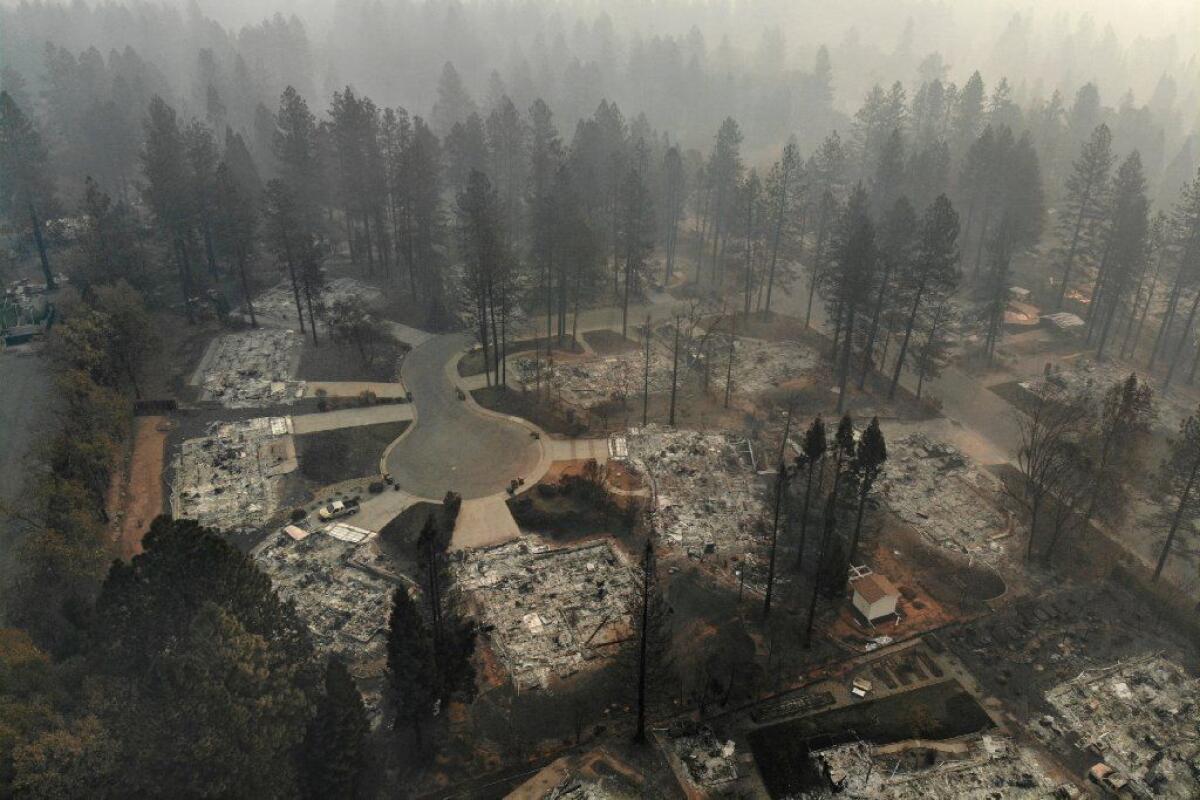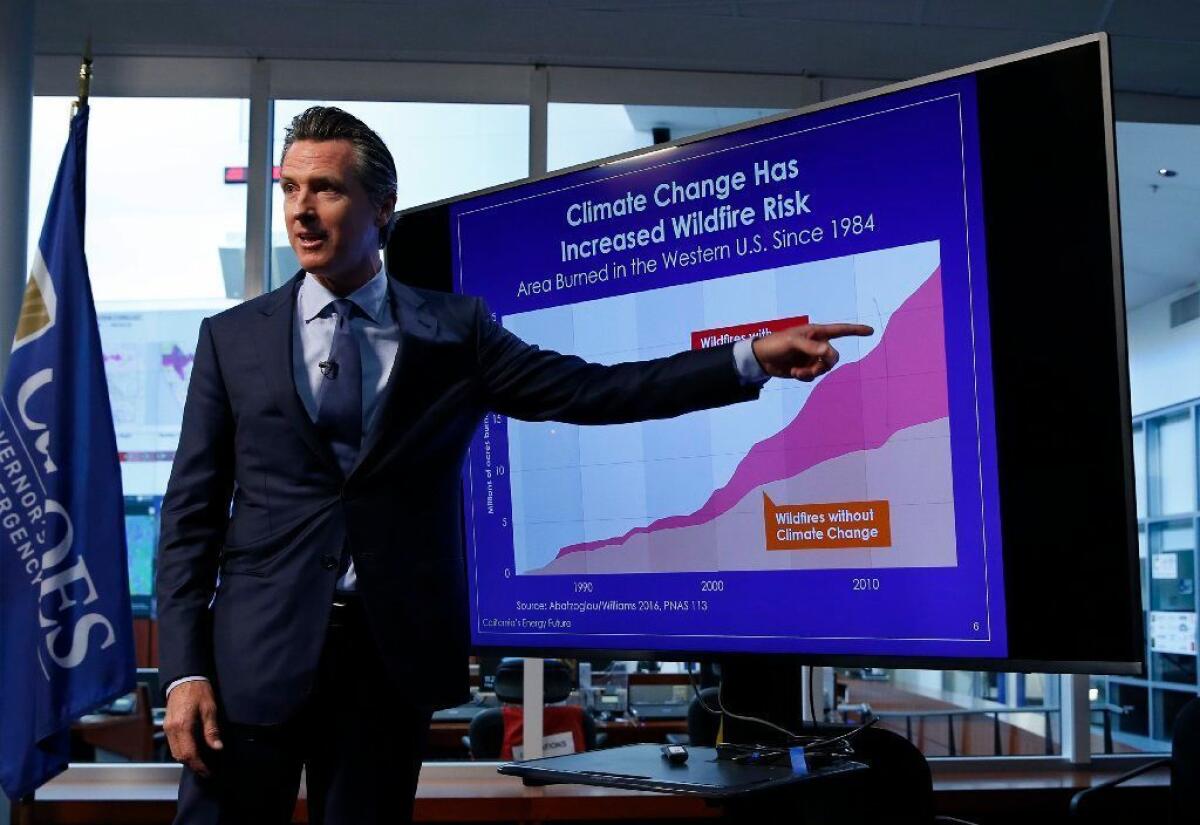SCE says investors need bigger profits because of fire risks

- Share via
The fallout from Pacific Gas & Electric’s bankruptcy is spreading to Southern California, where customers of the state’s second-largest electric utility could see their energy bills rise by $290 million a year — if federal officials allow the utility to reward shareholders with dramatically higher profits.
Southern California Edison says it needs higher profits to keep attracting investment following a series of deadly fires sparked by utility-owned electrical equipment that have sent utility stock prices tumbling. Edison doesn’t face as much financial risk as its Northern California counterpart, PG&E. But Pedro Pizarro, president of Edison’s parent company, recently said his utility could be one big fire away from bankruptcy.
In a recent filing, Edison asked the Federal Energy Regulatory Commission for permission to increase its shareholders’ return on equity from just over 11% to just over 17% — a number far out of line with industry standards, but which Edison says is justified because of the growing risk of destructive fires, fueled in part by climate change. The utility says an average residential customer would see a monthly bill increase of about $2.20 starting this summer, if federal officials sign off.
Caroline Choi, Edison’s senior vice president of corporate affairs, said giving investors a 17% return on investment isn’t a sustainable, long-term strategy for dealing with fire risks. But in the short term, Choi said in an interview, the company needs higher guaranteed profit margins to secure funding for key initiatives, including safety.
“We are having to make significant investments to harden the grid and make it more resilient to wildfire. We’re also making investments to support the state’s clean energy goals,” Choi said. “In order to attract the capital we need to make those investments, we need a return on investment that reflects the operating risks that we have today.”
Ratepayer advocates are crying foul.
Matthew Freedman, an attorney at the San Francisco-based Utility Reform Network, sees Edison’s request as a tactic to pressure state lawmakers. Gov. Gavin Newsom and the Legislature are debating how the state should pay for wildfire damage in an era of climate change and whether to shield investor-owned utilities from the full liability of fires ignited by their equipment.
Freedman described Edison’s request for higher profits as “an attempt to intimidate state lawmakers into taking actions favorable to Edison’s interests.” That theory is backed up by Edison’s news release, which says the dramatic increase to shareholder profits could be removed from rates “once state policymakers have restored certainty and stability to how wildfire-related costs are addressed.”
“They’re attempting to extort relief from the state of California by pressing for obscene rates of return from federal regulators, based on the premise that wildfire liability risks require this level of profitability for the transmission system,” Freedman said.

Shareholders of California’s major monopoly electricity companies — Edison, PG&E and San Diego Gas & Electric, which is owned by Sempra Energy — have been allowed to earn returns of 10%-12% on state-regulated assets over the last decade, according to the California Public Utilities Commission. Across the country, electric utility profits approved by state officials averaged 9.45% in the fourth quarter of 2018, down from nearly 13% in the early 1990s, according to data compiled by an industry trade group.
Tyson Slocum, who leads the energy program at the national consumer advocacy group Public Citizen, said he plans to file a formal objection to Edison’s request for a 17% return. The proposal shifts too much of the financial risk of wildfires from Edison’s shareholders to its ratepayers, he said.
“It’s enormously generous financially for what is designed as a monopolistic investment endeavor,” Slocum said. “I think we’ve got to find another type of policy mechanism to deal with the liability issue.”
State lawmakers are working on new policies with the goal of keeping additional utilities from filing for bankruptcy or losing their ability to borrow money at low rates — all without shifting too much of the burden to ratepayers. It’s a fine line to walk, with political risk on either side. Newsom weighed in on the debate this month, outlining ideas that have been proposed but declining to endorse a particular solution.
PG&E filed for Chapter 11 bankruptcy protection in January, estimating that it faced $30 billion or more in potential wildfire liabilities. Investigators have found the utility’s equipment sparked or contributed to more than a dozen fires than collectively killed 22 people in 2017, and PG&E says its infrastructure probably also helped start the Camp fire, which killed 85 people and destroyed the town of Paradise.
For California fire survivors, hope grows amid the ashes of Paradise »
Although Edison has stayed out of bankruptcy court, its power lines were determined to have sparked the 2017 Thomas fire in Santa Barbara and Ventura counties. The blaze killed two people and played a role in the ensuing Montecito mudslides, which killed 23 people. In recent months, Edison has seen its credit ratings downgraded due to fire risks, as has San Diego Gas & Electric.
Some California officials say that shoring up the utilities’ finances is key to meeting the state’s climate change goals, including a target of 60% renewable energy by 2030 and a mandate to reduce planet-warming carbon emissions 40% by the same year. Michael Picker, president of the California Public Utilities Commission, recently described the investor-owned utilities as “vehicles that we use to invest to meet social goals,” including cleaner energy production and the installation of electric vehicle chargers.
“We need those utilities,” Picker said this month at a Los Angeles Business Council sustainability summit. “They string miles and miles and miles of electric wires to communities that have been building out in wildfire zones, far from cities, because that’s where people are moving.”

Picker’s agency is responsible for determining how big a profit Edison’s shareholders are allowed to make on most of the company’s infrastructure investments. The main exception is shareholder returns on transmission-line projects, which generally fall under the jurisdiction of the Federal Energy Regulatory Commission, or FERC.
Edison’s request for a 17% return on equity would affect the relatively small portion of customer bills covering FERC-regulated assets. But Edison also plans to file a new “cost of capital” request with the Public Utilities Commission covering the rest of its infrastructure investments by Monday. If that request is anywhere in the ballpark of 17%, customers could see bill increases much larger than $2.20 per month.
“It’s a shock-the-conscience kind of number,” said Freedman, from the Utility Reform Network. “I’ve never heard of a return on equity of that magnitude being granted.”
Q&A: Edison CEO talks wildfires, climate change and the utility’s vanishing monopoly »
Some experts say Edison’s request for higher profits is reasonable.
Stanford University professor Michael Wara, who was appointed by Newsom to a commission on wildfire costs and utility infrastructure, thinks the 17% figure sought by Edison is too high. In a Twitter thread, Wara described the number as “insane,” saying it was calculated based in part on the unrealistic assumption that state officials will never allow an investor-owned utility to recover wildfire costs from its customers.
But in a follow-up interview, Wara said Edison’s request for higher profits is “basically the right idea” — especially when the company has pledged to spend hundreds of millions of dollars on projects to reduce the risk of fires sparked by its poles and wires.
“Until we can stabilize the situation, get wildfires under control, reduce risks for the utilities, we’re in this really difficult position,” Wara said. “Just saying, ‘Oh, the utilities are bad, and we’re not going to give them their rate of return’ isn’t adequate.”
Travis Miller, director of utilities research at investment analyst Morningstar, said Edison’s proposal is “substantially higher than any request we’ve seen in the industry recently.” But he acknowledged Edison’s circumstances are “out of the ordinary.”
“Investors are going to require a higher return to invest in a company that has more risk, and certainly Edison has more risk in the current environment than most of the other utilities in the U.S,” Miller said.

Edison officials say they’d support reducing shareholder returns back to current levels once lawmakers approve a plan for assigning wildfire costs. Proposals being discussed include a special fund to help utilities cover fire-related payouts and shielding utility shareholders from fire liability unless a utility is found to have acted negligently.
But it’s not clear that whatever comes out of Sacramento will satisfy Edison and its shareholders, or how soon lawmakers might act. Assemblyman Chris Holden, a Pasadena Democrat who chairs the chamber’s Utilities and Energy Committee, said at the L.A. Business Council’s sustainability summit this month that lawmakers won’t be rushed into action by dire warnings from credit rating agencies.
“They need to kind of stand down a little bit, because they’re scaring everybody with every headline that they write, with every downgrade that they propose, and they’re not giving us enough opportunity,” Holden said. “It’s designed to put pressure on us to move sooner than later. But I think we’re going to move smart, and not too fast.”
More to Read
Inside the business of entertainment
The Wide Shot brings you news, analysis and insights on everything from streaming wars to production — and what it all means for the future.
You may occasionally receive promotional content from the Los Angeles Times.











